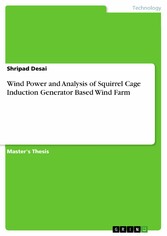Suchen und Finden
Wind Power and Analysis of Squirrel Cage Induction Generator Based Wind Farm
Master's Thesis from the year 2018 in the subject Engineering - Power Engineering, grade: 9, , language: English, abstract: The rising demand of electricity and the environmental concern in the recent past necessities the need of renewable energy sources. The Renewable energy sources have gained major importance due to the depletion of the conventional fuels in the future. Among the available renewable sources the Wind energy has gained a significant importance due to its high efficiency and pollution free nature. Large Wind Farms have been set up to meet the energy demand globally. The capacity of the Wind Turbine Generator is being increased gradually from a few KW capacities in the beginning rising up to almost 5 MW in the present. More research has to be carried in this field to make it a dominant source for the rising energy demand. Wind energy potential has to be harnessed on a large scale in places which have high wind density. Before the actual commissioning of the Wind Farm on site, a wide range of analysis has to be carried in terms of simulation. This is done to understand the behavior of the system under various conditions and preventive actions if any are to be taken. The pre analysis gives us an idea of the selection of devices for higher efficiency and system reliability. This project is a research work carried in ETAP (Electrical Transient Analyzer Program), which is a Power System Simulation tool. The analysis carried out to demonstrate the capabilities of the SCIG (Squirrel Cage Induction Generator) based Wind Farm include Load Flow analysis, to find out the Power transferred to the Grid in normal condition at rated Wind Speed. Active Power Output at various Wind Speeds, which presents the efficiency of the Wind Farm at various range of wind speeds. Short Circuit analysis which is essential to determine the capability of the Wind Farm to recover from any abnormal conditions. Harmonic analysis to determine the Quality of power being delivered and the Harmonic Filter design to mitigate the Harmonic content if any in excess.Reactive Power analysis which is important considering the stability of the system and a suitable Capacitor design for reactive Power compensation. The WTG (Wind Turbine Generator) considered was a Type 2 Variable speed SCIG of 2.1 MW assigned in ETAP. The Wind Farm consisted of a total of 20 WTG's with a total capacity of 42 MW. The results obtained were compared with the theoretical values and were found to be the same. The analysis performed presented a clear indication of the future of Wind Energy in SCIG based Wind Farms.
Alle Preise verstehen sich inklusive der gesetzlichen MwSt.







